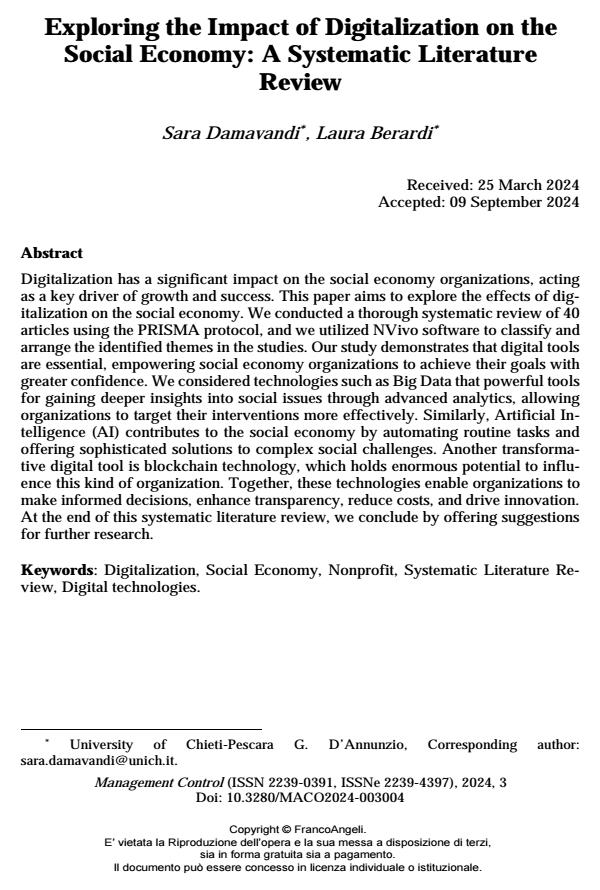Exploring the Impact of Digitalization on the Social Economy: A Systematic Literature Review
Titolo Rivista MANAGEMENT CONTROL
Autori/Curatori Sara Damavandi, Laura Berardi
Anno di pubblicazione 2024 Fascicolo 2024/3
Lingua Inglese Numero pagine 25 P. 61-85 Dimensione file 1785 KB
DOI 10.3280/MACO2024-003004
Il DOI è il codice a barre della proprietà intellettuale: per saperne di più
clicca qui
Qui sotto puoi vedere in anteprima la prima pagina di questo articolo.
Se questo articolo ti interessa, lo puoi acquistare (e scaricare in formato pdf) seguendo le facili indicazioni per acquistare il download credit. Acquista Download Credits per scaricare questo Articolo in formato PDF

FrancoAngeli è membro della Publishers International Linking Association, Inc (PILA)associazione indipendente e non profit per facilitare (attraverso i servizi tecnologici implementati da CrossRef.org) l’accesso degli studiosi ai contenuti digitali nelle pubblicazioni professionali e scientifiche
Digitalization has a significant impact on the social economy organizations, acting as a key driver of growth and success. This paper aims to explore the effects of digitalization on the social economy. We conducted a thorough systematic review of 40 articles using the PRISMA protocol, and we utilized NVivo software to clas-sify and arrange the identified themes in the studies. Our study demonstrates that digital tools are essential, empowering social economy organizations to achieve their goals with greater confidence. We considered technologies such as Big Data that powerful tools for gaining deeper insights into social issues through advanced analytics, allowing organizations to target their interventions more effectively. Similarly, Artificial Intelligence (AI) contributes to the social economy by auto-mating routine tasks and offering sophisticated solutions to complex social chal-lenges. Another transformative digital tool is blockchain technology, which holds enormous potential to influence this kind of organization. Together, these technol-ogies enable organizations to make informed decisions, enhance transparency, re-duce costs, and drive innovation. At the end of this systematic literature review, we conclude by offering suggestions for further research.
Parole chiave:Digitalization, Social Economy, Nonprofit, Systematic Literature Re-view, Digital technologies.
- Designing a green forward and reverse logistics network with an IoT approach considering backup suppliers and special disposal for epidemics management Sina Abbasi, Sara Damavandi, Amirhossein RadmanKian, Kian Zeinolabedinzadeh, Yigit Kazancoglu, in Results in Engineering 104770/2025 pp.104770
DOI: 10.1016/j.rineng.2025.104770 - Assessing barriers to blockchain technology adoption in food supply chains: a rough DEMATEL analysis Sara Damavandi, Jack H. Grant, Laura Berardi, Louise Manning, in British Food Journal /2025 pp.4851
DOI: 10.1108/BFJ-12-2024-1256
Sara Damavandi, Laura Berardi, Exploring the Impact of Digitalization on the Social Economy: A Systematic Literature Review in "MANAGEMENT CONTROL" 3/2024, pp 61-85, DOI: 10.3280/MACO2024-003004